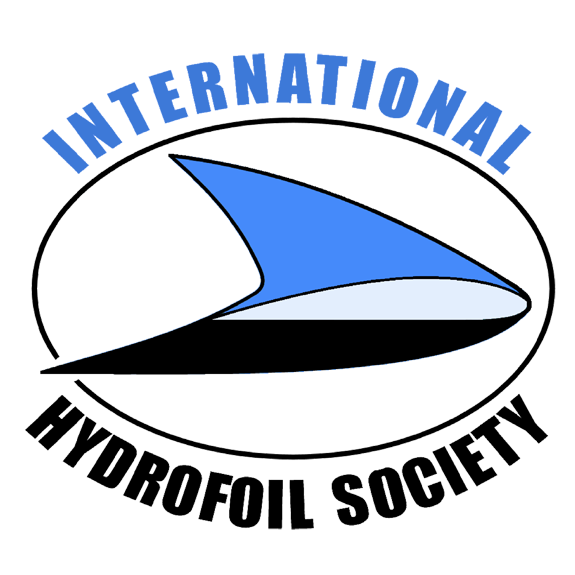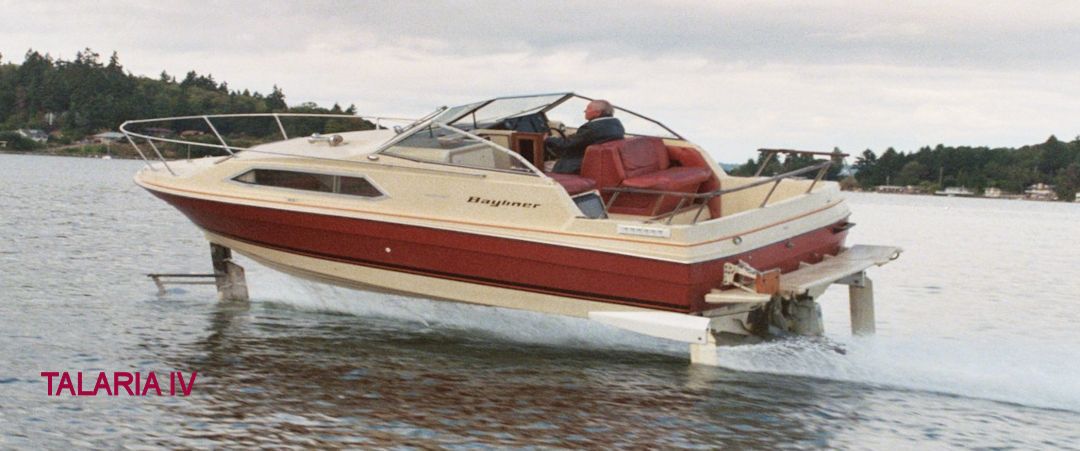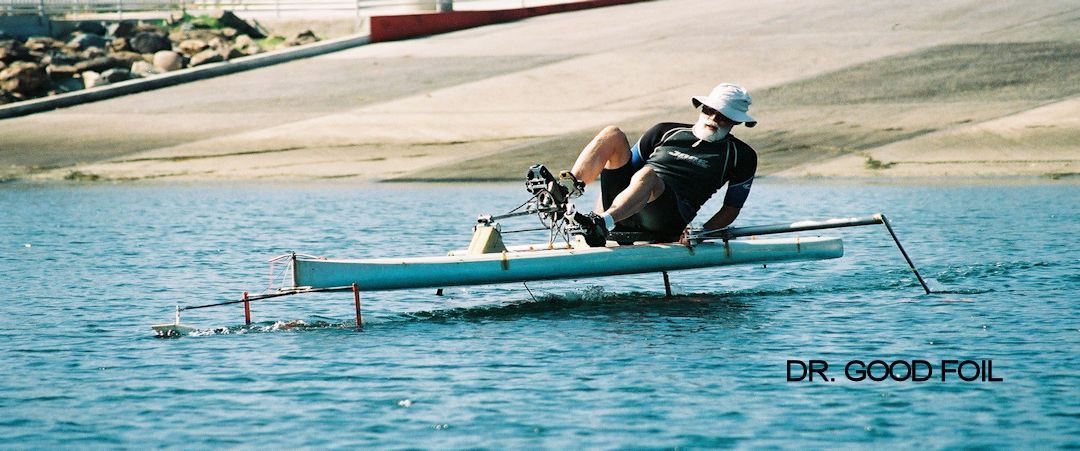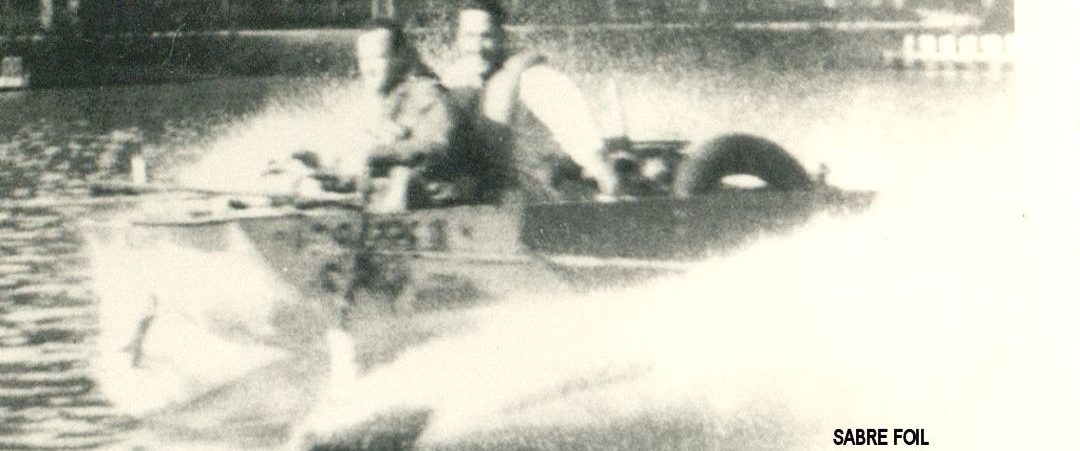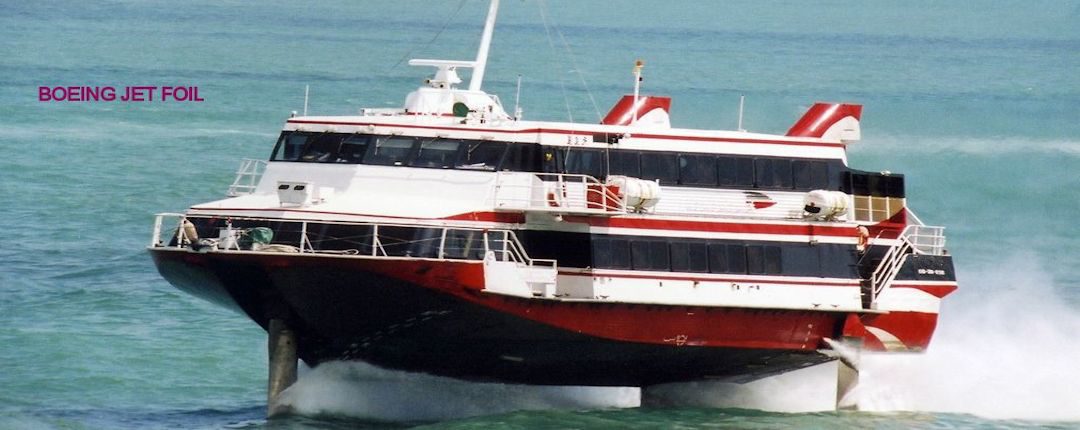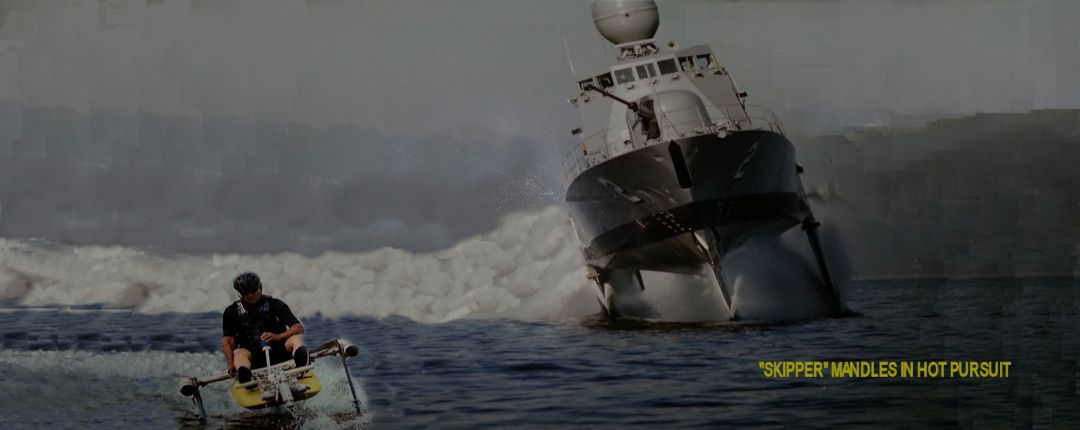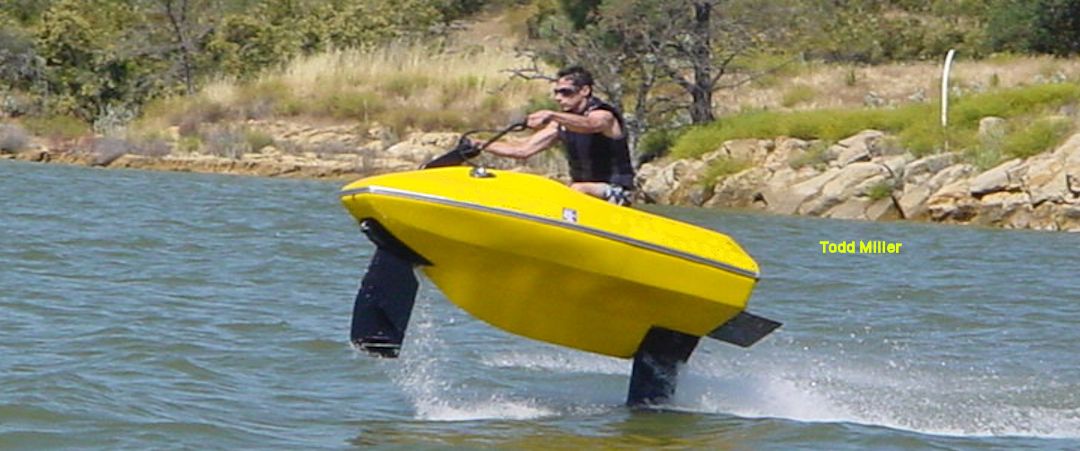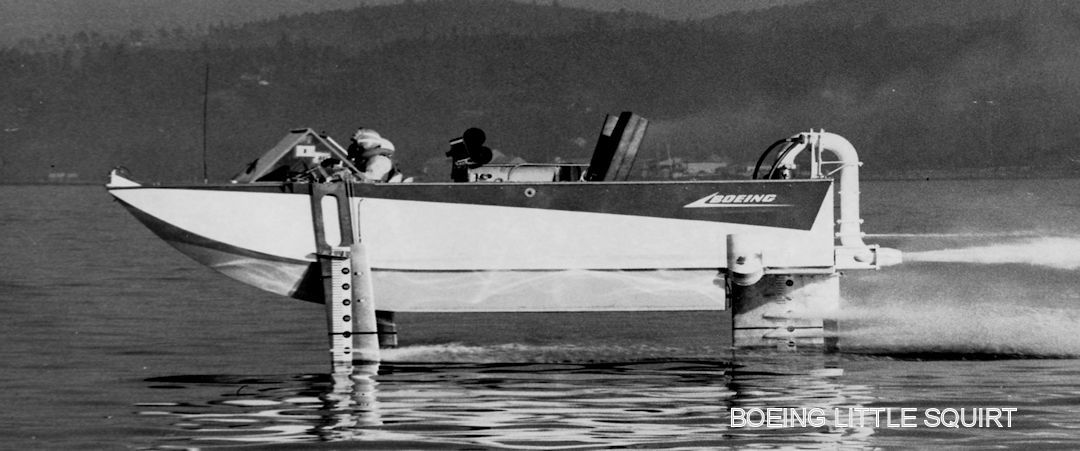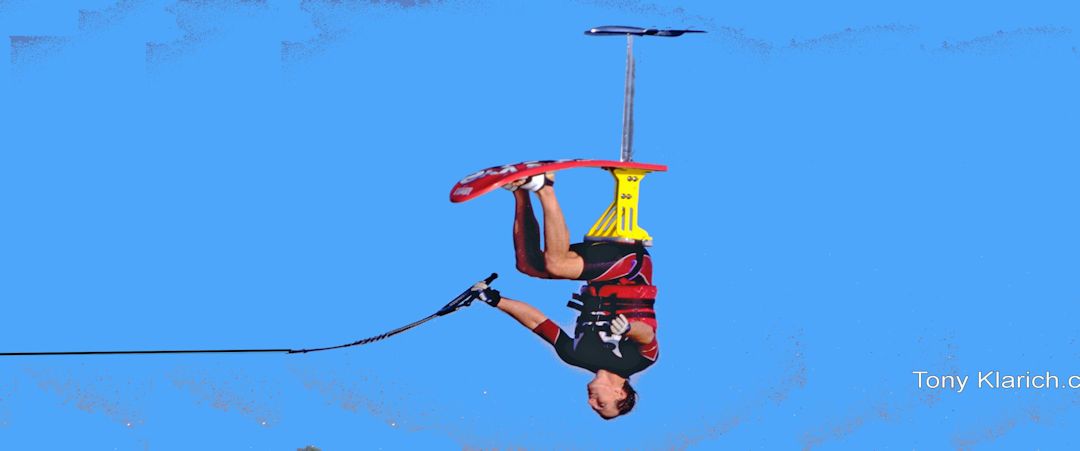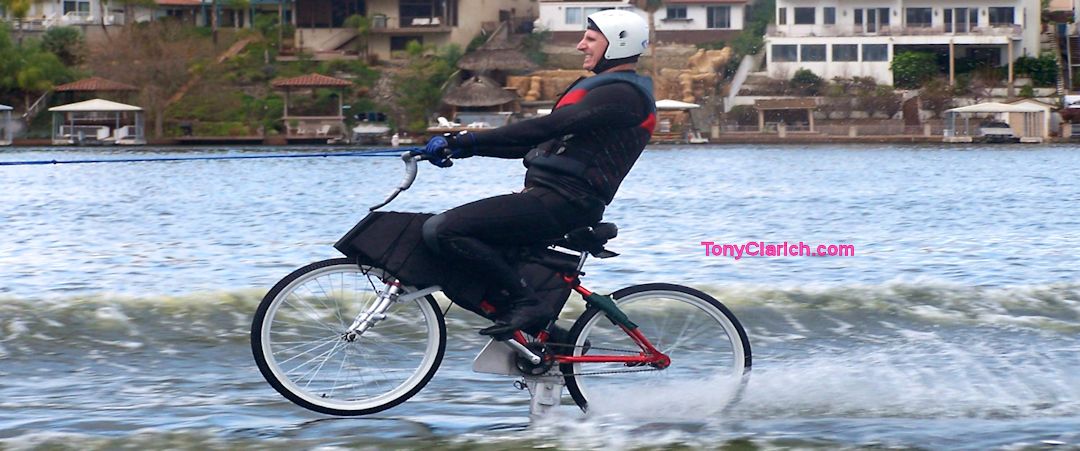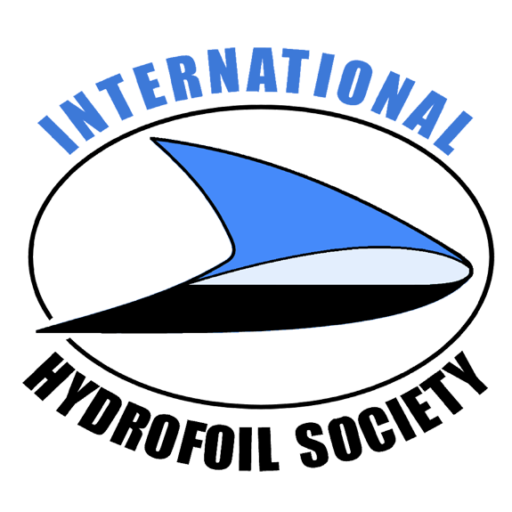U. S. Navy Hydrofoil Exhibit
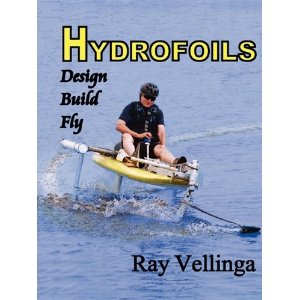
Hydrofoils: Design, Build, Fly

Hydrofoils: Design, Build, FlyThis is a book on how to design, build, and fly hydrofoil boats. It begins with the history and theory of hydrofoils, and continues with an explanation of flight characteristics, such as; stability, control, lift, drag, cavitation, and ventilation. Foil configurations, weight and balance, flying height, and roll management are covered as well as calculations of stress, hull configuration, and wing sizing. One section demonstrates methods for comparing designs, and explores specific design ideas for motorized, human powered, and sail powered hydrofoils. Piloting and trouble shooting are followed by a bibliography and index. This very complete book includes over 270 illustrations, charts and tables on the subject of creating hydrofoil boats. Because hydrofoils fly like airplanes, except in a denser fluid, the book’s subject could be described as aerodynamics adapted to hydrofoils. It is the best book available for hydrofoil enthusiasts. There is no other book like it.
Click here For more Information at Amazon.com
The PHM, Conception to Reality, A Difficult Birth
PHM History
Technical Journals, Papers, and Books
Technical Journals, Papers, and Books
International Hydrofoil Society Presents…
Sorry, no links available — Volunteers willing to create links are invited: contact IHSPresident2016@gmail.com
For Hydrofoil References in Popular Magazines and Books, Click Here For Information on the IHS Advanced Marine Vehicle CD-ROM, Click Here For More Bibliographies, Especially Sailing Related, Try the IHS Links Page) For FAQs, Posted Messages, and Discussion About Hydrofoil Design Texts, Software, and Sources, Click Here The Premier Sources For Descriptions and Principal Characteristics of Specific Military and Commercial Hydrofoils is Jane’s High Speed Marine Craft (formerly: Surface Skimmers, Hovercraft, and Hydrofoils) and Fast Ferry International Click Here To Suggest Additional Reference(s) Of course every IHS Newsletter is packed with articles about hydrofoils. To view an index of past articles in MS Excel format, Click Here
- Abbott and Von Doenhoff, ” Theory of Wing Sections” – Old but classic book still published in paperback form by Dover Publications, Inc.
- Acosta, A.J., “Hydrofoils and Hydrofoil Craft,” 1973, 24 pages, California Institute of Technology, Pasadena CA USA. Sponsored in part by Office of Naval Research, Washington, DC and Naval Ship Research and Development Center, Washington, DC. Published in Annual Review of Fluid Mechanics, v5 p161-184 1973. Abstract: The successful achievements of hydrofoil craft to date and the possibility of high speeds at sea are due to the greatly increased understanding in recent years of the flow past hydrofoils and to the development of foil configurations and control systems for coping with the roughness of the sea surface. It seems appropriate, therefore, to link the discussion of hydrofoils with that of progress in the craft. The general characteristics of hydrofoil craft are reviewed together with some representative modern examples. Some physical aspects of the flow past hydrofoils are described, followed by a resume of some of the recent methods used in design and analysis of hydrofoils. Available from: National Technical Information Service; 5285 Port Royal Road; Springfield VA 22151 USA. Source Data: AD-760230 u7313. Order Number: AD-760230
- Alternative Hullforms for High-Performance Ferries – SNAME technical report examines the hullforms available for high-performance ferries, including planing monohulls, catamarans and other multihull vessels, small-waterplane vessels, hydrofoils, hovercraft, air-cushion vehicles, surface-effect ships, WIGs, and channel-flow-wing craft. For each type, attributes and issues are cited, and tables of principal characteristics and photographs of examples are provided. This Technical and Research Report R-51, may now be ordered from cpujols@sname.org. The 35-page report, with 22 illustrations, is being issued as a compact disk, priced at $30 ($15 for SNAME members).
- Altman, R., “The Design of Supercavitating Hydrofoil Wings,” Technical Report 001-14, Hydronautics Inc., April 1968
- Aroner, R. and R. M. Hubbard, “DEH, A High Endurance Escort Hydrofoil For the Fleet,” AIAA Paper No. 74-311, AIAA/SNAME Advanced Marine Vehicles Conference, San Diego, California, February 25-27 1974.
- Asseo, S.J. and F. Dell’Amico, “An analysis of three hydrofoil boat control systems,” Cornell Aeronautical Laboratories, Inc. Buffalo, 1965.
- “Assessment of High Speed Waterborne Vessels and Their Builders,” Advanced Marine Systems Assoc, Inc; 9421 Chatteroy PL; Gaithersburg MD; Report No. UMTA-IT-32-0001-84-5, Aug 84, 191 pages. Available from NTIS, 5285 Port Royal RD; Springfield VA 22161. Abstract: Describes eleven of the most prominent firms in the design and construction of commercial high speed watercraft (HSW) craft, both domestic and international. The objective of this report is to identify and present data on the significant HSW vehicles currently available and their builders. For a number of vehicles currently in production and in operation, data is presented on the engineering and economic characteristics, energy efficiency, maintainability, reliability, ride quality, safety, comfort, accessibility to handicapped persons, and capital and operating costs. Engineering and economic comparison of these high speed vessels are also made with other modes of transportation.
- Astolfi J-A, Dorange P., Billard J.-Y., Cid Tomas I., 2000, “An experimental investigation of cavitation inception and development on a two-dimensional Eppler hydrofoil,” March 2000, Journal of Fluids Engineering, Vol. 122, pp. 164-173.
- Bailly-Cowell, G. M. (1967). “Hamburg to las Palmas on Foils.” Hovering Craft and Hydrofoil, 6(12) pp: 10-12
- Baker, Jr., Robert M. L., and James S. Douglas. “Preliminary Mathematical Analysis of a Rigid-Airfoil, Hydrofoil Water Conveyance.” Journal of Hydronautics 5.4 (1971): 140-147.
- Ball, Edgar Scott, Jr., Lessons Learned From the Patrol Hydrofoil Missile (PHM) Program, Thesis for Master of Science in Management, Naval Postgraduate School, Monterey CA, March 1979. “The PHM Project began as a major NATO acquisition program consisting of 60 or more ships for international purchase. Today the program cosists of just six ships for the United States alone. This thesis reviews the history of the program, the design considerations and the current problems experienced by the Program Manager. An analysis of the rationale behind the decisions which led to the reduction in scope of the program suggests that factors inherent to the current systems acquisition process cause the cut back in the program and that these were independent of the Program manager’s efforts. The results of the analysis suggest that these factors have the potential to affect the outcome of any acquisition program, no matter how well the hardware performs.” Approved for Public Release. Copy located in the Defense Technical Information Center, Defense Acquisition University, Fort Belvoir VA. http://www.library.dau.mil.
- Bender, E., Remington, P., “Hydrofoil Design for Minimum Control Power” B.H. Beranek and Newman Report 2511, 1973.
- “Bibliography – High Speed Waterborne Passenger Operations and Craft,” Authors: Advanced Marine Systems Associates, Inc, Urban Mass Transportation Administration, and Peat, Marwick, Mitchell and Co.; Report No. UMTA-IT-32-0001-84-2. Aug 84, 135 pages. Available from: Office of Technical Assistance, UMTA, 400 7th ST SW; Washington DC 20590 USA. Abstract: One of seven reports written under this contract to describe high speed waterborne passenger transportation, review its applicability in the US, and document its development in the free world. This report presents a comprehensive listing of available literature (in English) on the subject of High speed waterborne passenger transportation. Each reference in the bibliography indicates the source of the document, and whether the document contains information in the following categories: vehicle characteristics (e.g., craft features, performance and human factors); design consideration’; and economic/financial analysis of such services. Over 1,200 document written prior to Sep 82 are cited.
- Blade and Hydrofoil Section Design – The Society of Naval Architects and Marine Engineers (SNAME) has published the technical bulletin Blade and Hydrofoil Section Design. This bulletin includes the Blade and Hydrofoil Section Design Codes with a 29 page Owner’s Guide, and a 184 page Technical Report. It updates and complements T&R Bulletin 1-17. The Design Codes and Owner’s Guide provide tools for the design and performance evaluation of blade and hydrofoil sections. The programs are provided in both DOS and Mac formats and will run on most personal computers. The Technical Report provides analytical background information and is of interest primarily to those who wish to adapt or enhance the programs. This new publication is identified as Technical and Research Bulletin 1-45. It is being issued as a CD, and may be ordered by contacting cpujols@sname.org or by calling 201-798-4800. It is priced at $50 ($25 for SNAME members).
- Bovee, E.C., “Design and Construction of the PC(H) Hydrofoil Patrol Craft.” Paper Presented to Northwest Section Meeting, SNAME, Seattle WA, 5-6 October 1963.
- Brown, DK, JP Catchpole, and AM Shand, “The Evaluation of the Hydrofoil HMS SPEEDY,” Royal Institution of Naval Architects Transactions, Volume: 126, 1984, 16p., ISSN: 0035-8967. HMS SPEEDY was procured in 1979 to provide the Royal Navy with an opportunity to gain practical experience in the operation and support of a modern hydrofoil, to establish technical and performance characteristics, and to assess the capability of a hydrofoil in the UK ‘Offshore Tapestry’ role. The present paper describes the operational and technical evaluation of HMS SPEEDY undertaken in 1980-82, and outlines the results obtained. Supplemental Information: Transactions paper; Also in Naval Architect, January 1984 issue
- Buermann, T.M., Leehey, LCDR P. (USN), and CDR J. J. Stillwell (USN), “An Appraisal of Hydrofoil Supported Craft.” Paper Presented at SNAME Meeting, New York, NY, 12-13 November 1953.
- Bullock, Otis R. and Brian Oldfield, “Production PHM Hull Structure Producibility Design,” AIAA/SNAME Advanced Marine Vehicles Conference, Arlington, Virginia, September 1976.
- Charlier, Jacques J., (Catholic University of Louvain), “Jetfoils on the Ostend-Dover Route: A Technical and Commercial Appraisal,” Maritime Policy and Management, Vo. 17, Issue 2, Apr 90, pp 123-132.
- Chatterton, H.A., T.H. Sarchin, “Challenges to Hydrofoil Ship System Technology”, Naval Engineers Journal, February 1972.
- Chen, Jiahn-Horng, “A Regression Relation between Cavitation Number and Cavity Length for Two-Dimensional Supercavitating Hydrofoils,” Proceedings, National Science Council ROC(A) Taipei. (Link broken “http://nr.stic.gov.tw/” on 040120wnw)
- Christy, John, “Punch-Packing Sea Skimmers — Boeing’s Hydrofoils Are Some of the Fastest Water-Fliers Afloat Today,” International Combat Arms, The Journal of Defense Technology, May 1985 p.39, 68-74. (Background and capability summary and photos of PHMs, plus historical reference to and photos of Soviet hydrofoils such as Mo VI, PA-4, the P-6, P-8, P-10 classes if torpedo boats (foils retrofitted), Turya class, Matka class, and Pchela class, Sparviero, Nibbio class, TUCUMCARI, FLAGSTAFF, et al.
- Ciancitto, Antonino, Evoluzione dei Motori e Delle Macchine Terrestri, Marittime, Aeree e Spaziali… Dell’auto Electtrica al Naviplano dal Disco Volante al Razzo Cosmico. A technical book on the evolution of the engines and of the machines for land, sea, air and space. From the electric car to the hydrofoil ship; from the flying saucer to cosmic rockets. Evolution of helicopters and jet engines. Text in Italian. Well illustrated with technical line drawings and innumerable scientific formulae. 142 pages. Softcover.
- Clark, D.J.,W.C. O’Neill, D.C. Wight, “Balancing Mission Requirements and Hydrofoil Design Characteristics”, AIAA/SNAME Advanced Marine Vehicles Conference, April 1978, Paper 78-725.
- Coates, J.T.S., R.G. Merritt, and T.C. Weaton, “Why PHM? Further Studies on Roles and Missions”, AIAA Paper 78-729, AIAA/SNAME Advanced Marine Vehicles Conference, San Diego, California (April 17-19, 1978)
- Colucci, Frank; “Sweeping the Sea,” Air International, Vol. 49, No. 2, August 1995, pp 73-78. Discusses airborne mine sweeping system history. It includes two photos of the Mk 105 hydrofoil sled, one of it being towed behind an MH-53E helicopter.
- Connor, G. G. (1967). “Power for Hydrofoils.” Hovering Craft and Hydrofoil, Vol. 6 No. (11) pp: 8-13
- Crew, P. R., “The Hydrofoil Boat; Its History and Future Prospects.” Quarterly Transactions, The Institution of Naval Architects, Vol. 100, No. 4, October 1958.
- Crimi, Peter. “Experimental Study of the Effects of Sweep pn Hydrofoil Loading and Cavitation.” Journal of Hydronautics 4.1 (1970): 3-9.
- Davis, Jack (Port Authority of New York and New Jersey), “Those Fabulous Flying Ferries,” Portfolio, Vol. 3, Issue 1, Mar 90, pp 33-40. Document Source: Northwestern University Transportation Library DAM2927
- Dogan, P., Decanico, F., Gamber, F. Mederios, R., “Hydrofoil Universal Digital Autopilot (HUD AD), Phase I Final Report” Charles Stark Draper Laboratory Report R-745, January 1973.
- Dogan, P., Gamber, F. S. and Decanto, F. T., “Hydrofoil Universal Digital Autopilot (HUDAP), Phase I Final Report.” Charles Stark Draper Lab, Mass. Inst. of Tech., Report 745, January 1973.
- Duff, Karl M., H. Schmidt, and M.R. Terry, “The NATO PHM Ship and Weapons Systems Technical Evaluation Program”, AIAA Paper 76-848, AIAA/SNAME Advanced Naval Vehicles Conference, Arlington, VA, Sept 20-22, 1976.
- Duff, Karl M., “The NATO Patrol Missile Hydrofoil (PHM)”, AIAA Paper No. 72-596, AIAA/SNAME/USN Advanced Marine Vehicles Meeting, Annapolis, MD, July 17-19, 1972.
- Duff, Cdr. Kark M. “The NATO Patrol Missle Hydrofoil (PHM).” Journal of Hydronautics 7.3 (1973): 97-103.
- Eames, M. C. and T. G. Drummond, “HMCS BRAS D’OR-Sea Trials and Future Prospects”, Transactions Royal Institute of Naval Architects, Vol. 115, 1973.
- Eames, M. C. and Jones, E. A., “HMCS BRAS D’OR-An Open Ocean Hydrofoil Ship.” Transactions Royal Institute of Naval Architects, Vol. 113, 1971.
- Eames, M. C., “A Review of Hydrofoil Development in Canada.” Paper Presented at 1st International Hydrofoil Society Conference, Ingonish Beach, Nova Scotia, Canada, 27-30 July 1982.
- Ellsworth, W. M., “The US Navy Hydrofoil Development Program-A Status Report.” AIAA Paper 67-351, Presented at AIAA/SNAME Advanced Marine Vehicles Meeting, Norfolk, VA, 22-24 May 1967.
- Ellsworth, W. M., “Twenty Foilborne Years – The US Navy Hydrofoil HIGH POINT, PCH-1″, David Taylor Research Center, 1987.
- Eppler, Richard, “Airfoil Design and Data,” Springer-Verlag, 1990.
- “Evaluation of the Boeing JETFOIL SPEEDY in the Fishery Protection Role”, Article in Combat Craft, p. 158, July 1983.
- Existing and Former High Speed Waterborne Passenger Transportation Operations in the United States, Aug 1984, Report No: UMTA-IT-32-0001-84-3; Publisher/Corporate Author(s): Peat, Marwick, Mitchell and Company; 1990 K Street, NW; Washington DC 20006, Urban Mass Transportation Administration; Office of Technical Assistance, 400 7th Street, SW; Washington DC 20590; and Advanced Marine Systems Associates, Inc.; 9421 Chatteroy Place; Gaithersburg MD 20879 USA. Abstract: This is one of seven reports written under this contract to describe high speed waterborne passenger transportation, review its applicability in the United States, and document its development in the free world. This report reviews the history of high speed waterborne passenger transportation in the United States. High speed is defined as operating at 25 knots or greater. A summary is included which outlines the principal causes of success or failure of the 19 U.S. operations in the report. Failure of high speed waterborne transportation as a public transit mode in the United States has usually been due to some combination of the following four factors: use of an unproven technology; use of only one boat; insufficient market research, resulting in the selection of routes with insufficient market potential: and insufficient capital. Available from: Urban Mass Transportation Administration; Office of Technical Assistance, 400 7th Street, SW; Washington DC 20590 USA
- Ford, T. (1967). Seaspeed. Hovering Craft and Hydrofoil, 6(12) pp: 30-31, 6
- Frauenberger, H.C., “SHIMRIT Mark II Hydrofoil For The Israeli Navy”, Paper Presented at 1st International Hydrofoil Society Conference, Ingonish Beach, Nova Scotia, Canada, 27-30 July 1982.
- Gallington, Roger W. “Ram Wing Surface Effect Boat.” Journal of Hydronautics 7.3 (1973): 118-123.
- Gamber, F. and R. Medeirus(Medetrios?), “Hydrofoil Universal Digital Autopilot (HUDAD) Phase II Final Report”, Charles Stark Draper Laboratory, Report R-817, May 1974.
- Gebhardt, John C., “The skin friction of a hydrofoil near a free surface,” Ann Arbor, University of Michigan, 1968.
- Gibson, G. R. (1967). “Expo 67 – c
- Giuffrida, G. (1967). “Improvement in Foilborne Navigation.” Hovering Craft and Hydrofoil, 6(11) pp: 17-19
- Graham, C., T.E. Fahy, J.L. Grostick, “A Comparative Analysis of Naval Hydrofoil and Displacement Ship Design”, SNAME Transactions, 1976.
- Graig, W. A. “Comment on “Canadian Advances in Surface-Pierciing Hydrofoils”.” Journal of Hydronautics 8.2 (1974): 74-76.
- Grimm, Martin, “Transverse Stability of Surface Piercing Hydrofoils,” International Hydrofoil Society Newsletter, Summer 1998, pp. 7-9. The stability criteria presented in the IMCO Code of Safety for Dynamically Supported Craft, now superseded by the International Maritime Association (IMO) High Speed Craft Code, provides an equation for assessing foilborne metacentric height (GM) of surface-piercing hydrofoils in the design stage. An alternative method which addresses several limitations of this equation has been implemented in a short computer program, and representative results for typical foil designs are presented. A more extensive assessment of the results, a source code listing, and example input files are available from the author to those willing to examine this subject in further detail and share their findings. Click Here to view the article in Adobe Acrobat format.
- Griswold, John W., “PHM/JETFOIL Reliability and Service Experience,” AIAA/SNAME Advanced Marine Vehicle Conference, Arlington, Virginia, September 1976.
- “Grumman M161 – Israel’s Combat Hydrofoil”, Defense Attaché, pp 11-21, No. 5, 1981.
- “Guide For Implementing High Speed Waterborne Passenger Transportation Services,” Authors: Advanced Marine Systems Associates, Inc, Urban Mass Transportation Administration, and Peat, Marwick, Mitchell and Co. Sep 84. Available from: Office of Technical Assistance, UMTA, 400 7th ST SW; Washington DC 20590 USA. Abstract: This guide is designed as a technical report for potential High Speed Waterborne (HSW) service operators, craft builders, and investors. It is intended to assist in the key tasks required to assess the feasibility of and implement HSW service. These tasks include market analysis; selecting HSW craft; fulfilling regulatory requirements; obtaining financing; and developing and implementing service. The disappointing record to date of implementing HSW service in the US demonstrated the need for this guide. This guide draws on the lessons learned from these past attempts to start HSW service in the US as well as on the experiences of many successful foreign HSW operators. It should be recognized that any compilation of data and methods for evaluation will have some limitations. Recognizing these limitations before initiating a feasibility evaluation will improve the overall accuracy of the results. Limitations can be placed in the following categories: vehicle characteristics that are continually being modified and improved; newly available and proven HSW vehicles will replace some of the HSW vehicles listed; regulatory decisions that may change from location to location and from time to time; and ridership that may be influenced by local, political, and economic considerations.
- Guidoni, A., Seaplanes – “15 years of Naval Aviation”, Journal R.A.S., vol. XXXII, no. 205, Jan 1928, pp. 25-64
- Hamilton, F. M., C.W. Pritchett, and H.H. Hudgins, “Technical and operational characteristics of high performance watercraft;” Washington, D.C. : U.S. Coast Guard, Office of Research and Development ; Springfield, Va. : Available through the National Technical Information Service, 1975.
- Haney, Dan G. and Stanton R. Smith, “Economic Feasibility of Passenger Hydrofoil Craft in U.S. Domestic Foreign Commerce;” prepared for Maritime Administration, U.S. Dept. of Commerce. Stanford Research Institute. Menlo Park, Calif. : [distributed by Office of Technical Services, U.S. Dept. of Commerce], 1961
- Hayward, L., “The History of Hydrofoils.” A Series of Articles Published in Hovering Craft & Hydrofoils, Kalerghi Publications, London, England, Vol. 5, 1966.
- Hefazi, Hamid; Orhan Kural; Hsun Chen; and Tuncer Cebeci, Professors; Eric Besnard, Adeline Schmitz, Kalle Kaups, and George Tzong, Research Associates, “Hydrofoil Design and Optimization for Fast Ships, Proceedings of the 1998 ASME International Congress and Exhibition Anaheim, CA, Nov, 1998. Abstract: The paper presents a multi-disciplinary design/optimization method for the conceptual design of a hydrofoil based fast ship. The method is used to determine the maximum achievable lift-to-drag ratio (L/D) of an isolated foil-strut arrangement (hopefully greater than 50) at high transit speeds (greater than 75 knots) while lifting masses of 5,000 and 10,000 tons. First, the tools necessary for the study are presented. They comprise a panel method to compute three-dimensional flows around arbitrary configurations with a model for the free surface, a foil cross-section optimization tool, a strut cross-section design tool, and a structural analysis tool. The computational tools are then integrated into a multi-disciplinary design/optimization approach, which is applied to the design of single foil and biplane configurations. Results show that the goal of L/D = 50 is achievable for 75 knots (assuming that techniques can be developed for reducing the skin friction drag to a quarter of its nominal value) and, that for 90 knots, L/D ratios around 45 can be reached. The corresponding break horsepower requirements for 10,000 tons are around 130 khp and less than 200 khp, respectively. Full text posted at: www.csulb.edu/colleges/coe/ae/ae_dept/images/pdf/asme_paper.pdf
- Hockberger, William A., “Defining a Ferry Business.” Paper presented at the SNAME1997 Transportation Operations, Management, and Economics Symposium at the Meadowlands Hilton Hotel, May 14-15, 1997.
- Hoerner, Sighard F., Dr. – Ing, Fluid-Dynamic Drag, Practical Information on Aerodynamic Drag and Hydrodynamic Resistance, published by the author, 1965 (also by the same author with Henry V. Borst: Fluid Dynamic Lift. Both books are a “must” for hydrofoil designers)
- Horn, Captain Frank, USN, “PHM Squadron Two Operational Experience”, AIAA/SNAME/ASNE 7th Marine Systems Conference, New Orleans, Louisiana, February 1983.
- Hydrofoil Handbook, Gibbs and Cox, Inc. New York, 1954. Prepared by Gibbs and Cox, Inc. acting as the design agent of the Bath Iron Works Corporation under Office of Naval Research contract NONR-507 (00)
- Ikonnikov, V.V. and A.I.Maskalik. Osobennosty proektirovaniya i konstruktsii sudov na podvodnykh krylyakh. L., Sudostroyenie, 1987 (“Peculiarities of designing and constructing hydrofoils”, in Russian)
- Imlay, Frederick H, “Theoretical Motions of Hydrofoil Systems”, NACA Report 918, 1948. Results are presented of an investigation undertaken to develop theoretical methods of treating the motions of hydrofoil systems and to determine some of the important parameters. Variations of parameters include three distributions of area between the hydrofoils, two rates of change of downwash angle with angle of attack, three depths of immersion, two dihedral angels, two rates of change of lift with immersion, three longitudinal hydrofoil spacings, two radii of gyration in pitching, and various horizontal and vertical locations of the center of gravity. Graphs are presented. This 1948 report has been posted in full on the web by NASA. “The use of hydrofoils as an alternative to planing bottoms or hulls has been of interest for some time. Guidoni advocated the use of hydrofoils as a means of improving the take-off and rough=water performance of seaplanes as early as 1911.”
- International Hydrofoil Society, “Proceedings of the 25th Anniversary Celebration and Conference”, Collection of Hydrofoil Papers, Washington, D.C., June 1995. (Copies still available. The cost per copy for mail delivery in the USA or Canada is US$18.50. For delivery to other countries, the cost per copy is US$25.00. Send questions about the Proceedings to IHS Treasurer. For instructions on how to order, Click Here.
- Irvine, James F. and Donald T. Blake, “Operational evaluation of the hydrofoil concept for U. S. Coast Guard missions, Phase I : Report of operations with the USCGC Flagstaff (WPBH-1)” Washington : U. S. Coast Guard, Office of Research and Development, 1975.
- Irvine, James F. and Donald T. Blake, ” Operational evaluation of the hydrofoil concept for U. S. Coast Guard missions, Phase II : Record of additional operations with USCGC Flagstaff (WMBH-1);” Washington : U. S. Coast Guard, Office of Research and Development, 1975.
- Irvine, James F. and Donald T. Blake, “Operational evaluation of the hydrofoil concept for U. S. Coast Guard missions, Phase III : Report of operations with USCGC High Point (WMEH-1);” Washington : U. S. Coast Guard, Office of Research and Development, 1975.
- Jackson, L. J., “Recent PHM Operational Experience”, ASNE Proceedings of High Performance Marine Vehicles Conference, Arlington VA, June 1992.
- Jaques, Bob, “Eggshells on Razor Blades Revisited: High-Speed Craft – Dismissed As Eggshells On Razorblades in Their Hydrofoil Infancy — May Have Revolutionized Ferry Operations of Late, But Old-Fashioned Safety Worries Are Resurfacing, Seatrade Review 1996
- Jeffrey, N. E., and W. E. Ellis. “Proteus-A Versatile Vehicle for Open-Water Hydrodynamics Research.” Journal of Hydronautics, Vol 4. No. 2, April 1970: 60-65.
- Jeffrey, N. E. and M. C. Eames, “Canadian Advances in Surface-Piercing Hydrofoils.” SNAME Journal of Hydronautics, Vol. 7. No. 2, April 1973.
- Jewell, D. A. “Hydrofoil Performance in Rough Water”, Paper presented at AIAA/SNAME Advanced Marine Vehicles Conference, San Diego, CA, February 25-27, 1974.
- Johnston, Robert J., and John R. Meyer, “100 Years of Overcoming Archimedes Principle”, SNAME Southeast Section Centennial 1893-1993, February 9-10, 1993.
- Johnston, Robert J. and O’Neill, Wm. C., “A Ship Whose Time Has Come-and Gone”, Paper presented at AIAA/SNAME Advanced Marine Vehicles Conference, Baltimore, MD, 2-4 October 1979.
- Johnston, R.J. and W.C. O’Neill, “The Development of Automatic Control Systems for Hydrofoil Craft”, International Hovercraft, Hydrofoil and Advanced Transit Systems Conference, Brighton, England, May 1974.
- Johnston, R.J., “Historical Perspective”, Hydrofoil Lecture Day, Massachusetts Institute of Technology Professional Summer, July 8, 1975.
- Johnston, Robert J., “History of US Involvement in Developing the Hydrofoil.” Paper Presented at 1st International Hydrofoil Society Conference, Ingonish Beach, Nova Scotia, Canada, 27-30 July 1982.
- Jones, E. A., “RX Craft, a Manned Model of the RCN Hydrofoil Ship BRAS D’OR.” SNAME Journal of Hydronautics, Vol. 1, No. 1, July 1967.
- Kaji, M., Y. Nishi, and Y. Yamagami, “Prediction Method of Motions of Hydrofoil Vessels,” Journal of the Kansai Society of Naval Architects, Issue 214, Sep 90, 6 pages. ISSN: 0389-9101. Abstract: To respond to the need for high speed transportation, the hydrofoil vessel, supported partially or totally by foil lift, has been widely investigated. Because these investigations have included few studies of hydrofoil vessel motions, however, the authors studied these motions both theoretically and experimentally. They show that the unsteady characteristics of the hydrofoil have to be included in the hydrodynamic coefficients of the motion equations used for prediction. It is also confirmed, based on experiments, that lifting link theory is useful for calculation the unsteady characteristics of the three-dimensional hydrofoil under a free surface.
- Kaplan, P., “Use of Jet Flapped Hydrofoils as Ships Anti-Pitching Fins”, Oceanics Report 6413.
- King, James H. and M. Devine, “HANDE-A Computer-Aided Design Approach for Hydrofoil Ships”, Naval Engineer’s Journal, Vol. 93, Issue: 1, April 1981. Presented at ASNE Day, 30 April-1 May 1981. Session Title: Ship Design III, Paper No. 3. Abstract: A powerful computer-aided design tool for use in hydrofoil ship engineering, the Hydrofoil Analysis and Design (HANDE) Program, is described. Its relevance, structure, features, and use are delineated. The value of HANDE for design verification and variation, research studies, and rapid response studies is related through case histories. Future application and development of HANDE and related design tools are forecast. Available from: American Society of Naval Engineers; 1012 14th Street, NW; Washington DC 20005 USA.
- King, James H., “The Evolution of the NIBBIO Class Hydrofoil From TUCUMCARI“, Paper Presented at 1st International Hydrofoil Society Conference, Ingonish Beach, Nova Scotia, Canada, 27-30 July 1982.
- King, John W., “The PHM-The NATO and US Requirements”, AIAA Paper No. 83-0614, AIAA/SNAME/ASNE 7th Marine Systems Conference, New Orleans, February 23-25,1983.
- Lacey, R. E., “A Progress Report on Hydrofoil Ships.” Quarterly Transactions, Royal Institution of Naval Architects, Vol. 107, No. 1, January 1965.
- Lang, Thomas G. “Preliminary Design of Hydrofoil Cross Sections as a Function of Cavitation Number, Lift, and Strength.” Journal of Hydronautics 4.3 (1970): 104-112.
- Lunde, J. K. and H. A. Walderhaug, “300 tons, 50 knots hydrofoil Craft;” second report (Johannes Krzywinski), 1916- [S.l.] : Office of Naval Research, [19??]
- Lynch, Thomas G., “The Flying 400”, Canada’s Hydrofoil Project, Nimbus Publishing Limited, Halifax, Nova Scotia, 1983, ISBN 0-920852-22-X.
- Mahig, J. “Effect of Sweep Angle and Drag on the Flutter.” Journal of Hydronautics 7.3 (1973): 104-108.
- Mandel, P., Seagoing Box Scores and Seakeeping Criteria for Monohull, SWATH, Planing, Hydrofoil, Surface Effect Ships, and Air Cushion Vehicles. March 1979. 98 pages, Report No: DTNSRDC/SDD-79/1 Final Rpt., ISBN: SF 43-411-291; ISSN: 62543N. Publisher/Corporate Author(s): David Taylor Naval Ship R&D Center, Bethesda MD 20084 USA. Abstract: Three seagoing box scores applicable to any vehicle operating on the surface of the ocean are defined and assessed. One of the box scores is directly useful for calculating the operational worth and the technical seagoing merit of vehicles performing ocean surveillance-like functions. The second box score is similarly useful for the ordinary transportation function of vehicles. The third box score is useful for measuring the technical seagoing merit of vehicles performing any function. This work brings together prescribed values of 18 seakeeping criteria for monohulls, small-waterplane-area twin-hull (SWATH) ships, planing craft, surface effect ships, and air cushion vehicles from sources indicated in the report. The nature of each criterion is discussed and the prescribed values of these 18 criteria for each vehicle type are compared and discussed. Although some of the prescribed values of these 18 criteria are not reconcilable, other values, obtained from independent sources, show remarkable agreement. At least one new criterion not included in Table 2 is needed for monohulls. Appendixes A, B, and C contain a useful summary of important results of Olson’s massive work in a form not presented in his work. The usefulness and limitations of the frequency and time domain ship motion data bases developed for monohulls are described in Appendix D. The existence of these two data bases makes it possible to calculate the values of several of the criteria of Table 2 by two completely independent means.
- Martin, M., “The Stability Derivatives of A Hydrofoil Boat – Part II”, Technical Report 001-10(II), Hydronautics Inc., January 1963
- Matveev Konstantin He has recently co-authored, with V. Dubrovsky and S. Sutulo, the book Small Waterplane Area Ships. In particular, he wrote a section on hydrofoils that provides simplified engineering methods for calculating lift and drag of low and high aspect ratio foils (including free surface effects), cavitation onset, vortex wash and wake behind a foil, and unsteady effects. Appendix G is on dynamic unloading and foil design, More information about this book and ordering information can be found at the Backbone Publishing web-site http://www.backbonepublishing.com/DreamHC/Page1.html. (070418 wnw)
- Matveev Konstantin I., and Ivan Ivanovich Matveev, “Hydrodynamic Sound Generation on a Hydrofoil,” 1996, 12th Conference On High-Speed Ship Design, Nizhiy Novgorod, Russia. Abstract: Mechanism of sound generation on a hydrofoil is considered. Mathematical model of the hydrofoil ‘singing’ effect is proposed. The frequencies of ‘singing’ are obtained. The theoretical results are compared with experiments. Contact the author to discuss: Konstantin I Matveev, email: matveev@hydrofoils.org, website: www.hydrofoils.org
- Matveev Konstantin I. and Ivan Ivanovich Matveev, “Estimation and Compensation of Hydrofoil Deformations During a Season of Operation,” International Hydrofoil Society Newsletter, Summer 2000; Abstract: “One of the restrictions on the use of commercial hydrofoil crafts, which have some advantages in comparison with common displacement ships, is the necessity for specialized maintenance of the foil systems. Such work usually requires complicated equipment and experienced specialists. This paper offers a new method effectively restoring a hydrofoil after foil damage. A simplified method for conservation of the lift coefficient, which greatly influences on ship’s performance, is obtained from consideration of the factors defining the lift. The technology of the process is briefly described. This method enables operators to reduce repair expenses and time drastically, which is very important during a season of operation.” Click Here to view the full text of the article. Contact the author to discuss: Konstantin I Matveev, email: matveev@hydrofoils.org, website: www.hydrofoils.org
- Matveev, Konstantin I. and Ivan Ivanovich Matveev, “Tandem Hydrofoil System,” Ocean Engineering 28 (2000) 253-261. Abstract: “A tandem hydrofoil system enables an improvement in the lift-drag ratio of a high -speed ship. The conditions for favorable application of this type of foil structure are determined. The data on hydrofoil boats using a tandem system are presented. The problem of the stability of the vertical plane motion for a hydrofoil with bow and stern foils is considered. The general conditions providing the stability are obtained.” Contact the author to discuss: Konstantin I Matveev, email: matveev@hydrofoils.org, website: www.hydrofoils.org. Copy can be found in libraries subscribing to Ocean Engineering, or it can be ordered directly from the publisher at http://www.elsevier.com/.
- Matveev Konstantin I., “Investigation of Hydrofoil ‘Singing’ in the Carman Approximation,” Phystech Journal, Vol.2, No.2, 1996. Abstract: “The effect of hydrofoil ‘singing’ has been investigated. The mechanism of sound generation is considered and a mathematical model of the process is proposed. The frequency of sound generated by a hydrofoil and the sounf intensity distribution are estimated. Experimental data are compared to calculations. Countermeasures against the hydrofoil ‘singing’ are proposed.” Contact the author to discuss: Konstantin I Matveev, email: matveev@hydrofoils.org, website: www.hydrofoils.org
- Merritt, R.G. and R.L. Herechkowitz, “Variations on a Single Theme: Future Configurations and Growth of the Patrol Hydrofoil Combatant (PHM)”, AIAA Paper 76-854, AIAA/SNAME Advanced Marine Vehicles Conference, Arlington, Virginia (September 20-22, 1976)
- Meyer, John R., and James R. Wilkins, “Hydrofoil Development and Applications” ASNE Proceedings of High Performance Marine Vehicles Conference, Arlington VA, June 1992.
- Meyer, John, Ships That Fly. About 10 years ago John collected a lot of material about hydrofoils and put it all together in a book called Ships That Fly. It became a story of the modern hydrofoil covering the early days of hydrofoil inventors and experimenters and taking the reader through over 150 pictures and illustrations of hydrofoils leading to those of recent years. He recently had the pages of the book scanned and put in a pdf file and placed on a CD that is being offered for sale.You will note that Chapter 6, The US Navy Fleet Hydrofoil-PHM, ends with a very optimistic view of PHMs in the current US Navy, and larger hydrofoils in its future. However, this was not to be. Several years following the completion of my book, Ships That Fly, there were events surrounding the US Navy PHM program that are described in an Addendum to Chapter 6. All six PHM ships were decommissioned on July 30, 1993. This was the only time the US Navy has decommissioned an entire class of ships on the same day. This addendum describes some of the events leading to this sad day for the US Navy and the hydrofoil community. Also, documented are the many attempts to save the Ship, the day of the ceremony, attempts to save the ships even after the decommissioning, and finally the subsequent disposal of the ships and their status today.John also collected a series of over 140 hydrofoil pictures and illustrations, and created a Hydrofoil Slide Show, entitled: A Century of Hydrofoil Development. All three of these files are on the CD. To find out more, log onto: http://themeyers.org/ShipsThatFly/index.html
- Miller, Boyce E., and Harvey P. Hack. “Impressed-Current Cathodic Protection.” Journal of Hydronautics July 1973: 108-111.
- Mitchell, T. R. … [et al.] “Hydrofoils for the fisheries law enforcement mission of the U. S. Coast Guard;” Washington : U. S. Coast Guard ; Springfield, Va. : Available through the National Technical Information Service, 1975.
- Mitchell, T.R., J.P. Donnelly, and J.A. Nevendorffer, “Observations of the performance of TUCUMCARI (PGH-2) in the U.S. Coast Guard mission oriented trials;” Arlington, Va., Center for Naval Analyses, 1973.
- Mitchell, T. R., L. S. Cohan, and C. H. Heider, “The utility of high-performance watercraft for selected missions of the United States Coast Guard;” Center for Naval Analyses, Arlington, Va. Arlington, Va. 1972.
- Modern Ships and Craft, Chapter V – Hydrofoils, Special Edition of the Naval Engineers Journal, February 1985. (Contact IHS for a copy).
- Moorwood, John, “Hydrofoil Options.” Amateur Yacht Research Society (AYRS), #90 July 1998 – Covers different design ideas and approaches for sailing hydrofoils.
- Myers, G.R., “Observations and Comments on Hydrofoils”, Paper Presented at the Society of Naval Architects and Marine Engineers Spring Meeting, Seattle, WA., May 13-14, 1965.
- Noreen, A.E., P.R. Gill, and W.M. Feifel, Boeing Marine Systems, Inc., “Foilborne Hydrodynamic Performance of Jetfoil,” Journal of Hydronautics, Vol. 14, No. 2, Apr 1980, pp. 56-62. The Boeing Jetfoil Model 929-115 hydrofoil ship was derived from Model 929-100, with increased forward foil area for larger load-carrying capacity. Forward and aft foil contours were revised to increase cavitation margin. New hydrodynamic design methods were employed to maximize foil thickness for minimum structural weight. Prediction of foilborne cruise performance was based upon theoretical analysis, model test data, and full-scale trial data from Model 929-100. Extensive flowfield observations were made of the foil systems during sea trials of the first Model 929-115 produced. Good agreement was found between predicted and observed cavitation and ship performance characteristics. Sensitivity of ship performance to operating variables was determined from sea trial data.
- Norwegian Institute of Transport Economics (1967). “Hydrofoil Boats or Hovercraft?.” Hovering Craft and Hydrofoil, 6(11) pp: 24-27
- Oakley, O. H., “Hydrofoils-A State of the Art Summary.” Proceedings of the Institute of Aeronautical Sciences, National Meeting on Hydrofoils and Air Cushion Vehicles, 17-18 September 1962.
- Olling, D.S., and R.G. Merritt, “Patrol Combatant Missile Hydrofoil-Design Development and Production – A Brief History”, High Speed Surface Craft, January-February 1981.
- “Operational testing and evaluation of the hydrofoil seacraft DENISON from June 1962 through 1963.” Grumman Aircraft Engineering Corporation. [Bethpage, N.Y., 1963?]
- Ostersehlte, Christian, “Tragflächenboote von der Unterweser — Die BREMER PIONIER und ihre beiden Vorgänger,” Bremisches Jahrbuch, Band 79, 2000, pp. 145 – 196. The predecessor boats of the title are the Focke-Schaper-Tragflächenboot (Aug 1951) and TOM-TOM II (Oct 1951).
- Patch, David A., “Operational Utilization of the Patrol Hydrofoil Missile (PHM)”, First International Hydrofoil Society Conference, Ingonish Beach, Nova Scotia, Canada, July 27-30, 1982.
- Peek, R. and L. Bauer, “M-151 Transmission for Mark II Hydrofoils,” AIAA-2084, September 1981.
- Petrie, D. M., “Operational and Developmental Experience on the US Navy Hydrofoil HIGH POINT.” AIAA Journal of Aircraft, Vol. 3, No. 1, January-February 1966.
- Pieroth, C., “Grumman Design M163, a 2400 Metric Ton Air Capable Hydrofoil Ship”, AIAA Paper 78-749, AIAA /SNAME Advanced Marine Vehicles Conference, San Diego, CA, April 17-19, 1978.
- Plotkin, A. “Laminar Boundary-Layer Induced Wave Forces on a Submerged Flat-Plate Hydrofoil.” Journal of Hydronautics 8.2 (1974): 47-52.
- Prandtl, Ludwig and Oscar G Tietjens; Applied Hydro- and Aeromechanics, ISBN: 048660375X. A text book of over 300 pages (5-3/8” x 8-1/2”). Prandtl was a leading aerodynamics theorist. This work has is reported as “one of the finest introductory works in the field”. Topics include flow through pipes, Prandtl’s own pioneering work on boundary layers, drag, airfoil theory, and entry conditions for flow in a pipe. Professor Tietjens is known for his research and development of experimental hydrofoil boats prior to and during the second world war. While it is uncertain whether the book deals specifically with hydrofoil hydrodynamics, it is listed by IHS due to the association of at least one of its authors with hydrofoil craft development. The book could be ordered through DoverPublications.com for $10.95 when this reference was spotted.
- Report to Congress: Study of High Speed Waterborne Transportation Services Worldwide, August 1984, Publisher/Corporate Author(s): Peat, Marwick, Mitchell and Company ; 1990 K Street, NW; Washington DC 20006, Office of the Secretary of Transportation ; 400 7th Street, SW; Washington DC 20590, Advanced Marine Systems Associates, Inc.; 9421 Chatteroy Place; Gaithersburg MD 20879 USA . Abstract: In response to Congressional mandate, UMTA engaged in an extensive evaluation of high speed waterborne (HSW) passenger transportation in the U.S. and throughout the free world. The study reviewed the history of HSW, determined its current status and examined factors that might impact its future development. Unsubsidized HSW operated by the private sector was emphasized in analyzing potential U.S. sites. The U.S. site analyses included domestic, as well as foreign craft. High interest rates and the investment required to establish HSW service make the financial feasibility of operations sensitive to the cost of capital. A vessel capable of satisfactory service must also have low initial costs and be economical to operate and maintain. As a group, craft of foreign origin meet these criteria best. Were foreign technology employed, the study indicated that HSW service could be operated profitably by the private sector in some markets. A study of 10 such sites, indicated that nine might, under certain conditions, be feasible. Conditions are: (1) Competitive in time with other transport services, (2) Competitive in cost; (3) Need to capture only a small share of an existing travel market for economic viability. Primary market for HSW abroad is travel times under 45 minutes. Despite relatively high seat-mile costs, travelers abroad often pay a premium fare for travel time savings, convenience and/or novelty of HSW. HSW craft operate safely in great variety of adverse locations. Foreign HSW development has been orderly with private sector and unsubsidized service often viable. In contrast, in the U.S. HSW has been beset by inadequate capitalization and has operated with unproven vessels. Available from: Office of the Secretary of Transportation ; 400 7th Street, SW; Washington DC 20590 USA; ID: 00390706
- “Review of Selected High Speed Waterborne Operations Worldwide,” Authors: Advanced Marine Systems Associates, Inc, Urban Mass Transportation Administration, and Peat, Marwick, Mitchell and Co.; Report No. UMTA-IT-32-0001-4, Aug 84. Available from: Office of Technical Assistance, UMTA, 400 7th ST SW; Washington DC 20590 USA. Abstract: One of seven reports written under this contract to describe high speed waterborne passenger transportation, review its applicability in the US, and document its development in the free world. This report describes high speed waterborne passenger transportation operations throughout the world. Information is presented on: ridership, the type, characteristics and number of craft used, operating conditions and characteristics, crew sites and wages, terminal facilities and maintenance procedures. The operators described were chosen because they exemplify the most frequently used types of craft and operating scenarios. Services are included that operate in Europe, South America, and the Far East. Not all existing operations are covered in this report due to time and budget limitations.
- Rieg, Donald F. and James H. King] “Technical evaluation of the RHS 200 for high speed ferry applications and Coast Guard missions ;” prepared for U.S. Department of Transportation, United States Coast Guard, Office of Research and Development. Rieg, Donald F. Washington, D.C. : The Office ; Springfield, Va. : Available through NTIS, 1984.
- Rodriquez, Leopoldo, Dino Di Blasi, “Current Status and Future Prospects for European Commercial Hydrofoils”, Paper Presented at 1st International Hydrofoil Society Conference, Ingonish Beach, Nova Scotia, Canada, 27-30 July 1982.
- Roess, R.P. and P.J. Grealy, “The Use of High-Speed Vessels in Urban Ferry Service: Issues and Economic Evaluation,” Transportation Research Record, Issue: 925, Inland Water Transportation. 1983. pp 9-12, Publisher/Corporate Author(s): Transportation Research Board; 2101 Constitution Avenue, NW; Washington DC 20418 USA; Abstract: The economic aspects of high-speed ferry operations are discussed and compared to conventional ferry services. The economic viability of high-speed service is demonstrated using conventional economic analysis techniques. Issues related to high-speed ferry operations such as safety, efficiency, and ridership attraction are discussed in more general terms. The paper concludes that high-speed ferry operations can compare favorably with conventional services and hold potential for attracting larger numbers of passengers and charging premimum fares. :Available from: Transportation Research Board Business Office; 2101 Constitution Avenue, NW; Washington DC 20418 USA. Order Number: DOTL JC
- Salvesen, Nils. “Seakeeping Characteristics of Small-Waterplane-Area-Twin-Hull Ships.” Journal of Hydronautics 7.1 (1973): 3-9.
- Schrider, M., “Study of Foil Influence on Foil-Borne Hydrofoil Performance”, Intersociety Advanced Marine Vehicles Conference, Arlington, VA, 5-7 June 1989.
- Shen, Y., Wermites, R., “Recent Studies of Struts and Foils for High Speed Hydrofoils” Marine Technology, Vol 16, January 1979.
- Shultz, W.M., “Boeing JETFOIL Model 929-100”, AIAA Paper No. 74-308, AIAA/SNAME Advanced Marine Vehicles Conference, San Diego, CA, February 25-27, 1974.
- Shultz, W.M., “Current Status And Future Prospects United States Commercial Hydrofoils”, Paper Presented at 1st International Hydrofoil Society Conference, Ingonish Beach, Nova Scotia, Canada, 27-30 July 1982.
- Sinnarwalla, Abbas M. and T. R. Sundaram, “On the changes in lift of hydrofoils due to surface injections of polymer additives;” Laurel, Md. : Hydronautics, Inc., 1978.
- Stark, D.R., “Ride Quality Characterization and Evaluation in the Low Frequency Regime, with Applications to Marine Vehicles,” Human Factors in Transport Research Volumes 1 and 2, Academy Press Inc. (London) LTD, and Conference on Ergonomics and Transport, Swansea, United Kingdom, 1980.
- Stark, D.R., “The PHM Automatic Control System”, SAE National Aerospace Engineering and Manufacturing Meeting, San Diego, CA, Oct. 1974.
- Stevens, D. L., Jr., “The Bureau of Ships Hydrofoil Craft FRESH-1.” Paper Presented to Chesapeake Section, SNAME, 26 February 1964.
- “Study of High Speed Waterborne Transportation Services Worldwide”, Urban Mass Transportation Agency, UMTA-IT-32-0001-84-3, August 1984, Seven Vols., National Technical Information Service (NTIS) #PB 85129906/U.
- “Study of Hydrofoil Seacraft” Vols. I and II, PB161759, 3 Oct 58, Phase I Technical Report by Grumman Aircraft Engineering Corporation to Maritime Administration, US Department of Commerce. “This report contains the results of a parametric study made to determine the feasibility of hydrofoil seacraft with speeds from 50 to 200 knots, gross weights from 100 to 3,000 tons, and ranges from 400 to 3,600 nautical miles. The relative merits of various combinations of hydrofoil craft parameters and the possible advantages of such craft over displacement vessels were thoroughly investigated. A detailed analysis of the various design features and operational characteristics of hydrofoil craft… is also included.”
- Sueoka, H, Tozawa, S., Sakai, F., Kabata, T.,”Structural Responses of Mitsubishi Super Shuttle 400, Rainbow, in Seaways”, Mitsubishi Heavy Industries, Ltd. (Japan), FAST ’95 Conference.
- Sugranyes Baena, Alcides, “‘KOMETA-M’ – Description and Handling of USSR Coastal Passenger Hydrofoil,” Hovering Craft and Hydrofoil, Kalerghi Publications, Vol. 1 No. 11, Aug 72
- Sullivan, E. K. and Higgins, J. A., “Test and Trials of the HS DENISON.” Published by the Maritime Administration, circa 1962.
- Swales, P. D., R. C. McGregor, and A.J. Wright. “Correlation of Force Measurements and Separated Flow Regions on Surface Piercing Struts.” Journal of Hydronautics April 1974: 72-73.
- Swales, P. D. R. C. McGregor,and A. J. Wright. “Explanation of Forces on a Surface.” Journal of Hydronautics July 1973: 132-133.
- Taiwan 106-36 Republic of China, Vol. 24, No. 2, 2000, pp. 120-129. Abstract: For convenience in engineering applications, we attempt to find a general regression relation between the nondimensional cavity length and the cavitation number for two-dimensional supercavitating hydrofoils. Based on observations of the general trend of the relation, a nonlinear function for these two physical quantities is proposed, and the coefficients in the function are optimally determined via a least-squares procedure and an iterative Gauss-Newton method. Several supercavitating hydrofoils, including flat-plate hydrofoils and hydrofoils with and without cambers, are investigated. The results seem to indicate that there exists a global approximate relation, the optimum coefficients of which depend on the flow conditions and hydrofoil shape. Key Words: 2-D supercavitating hydrofoil, potential flow, regression relation. Full text posted at: http://nr.stic.gov.tw/ejournal/ProceedingA/v24n2/120-129.pdf
- Terao, Yutaka; “Lateral and Roll-Yaw Coupled Motion Control of Hydrofoil Craft”, Proceedings of the 7th International Conference on Stability of Ships and Ocean Vehicles (STAB 2000), 7-11 February 2000, Launceston, Tasmania, Australia. AMECRC Ltd, Editor: Martin Renilson. pp 542 – 550. For those with a really technical bent, the mathematical modeling of the human operator using skilful body weight shift to maintain stability of a solar powered hydrofoil has been examined in this reference.
- Terao, Yukata; (Tokai University, Dept. of Naval Architecture, Japan) and H. Isshiki (Hitachi Zosen Corp, Japan), “Wave Devouring Propulsion (WDP) Sea Trial,” Undated. Abstract: The development of Wave Devouring Propulsion system and results of its sea trial on the HOKUTO are presented. WDP system is an idea not only for the ship propulsion system which converts wave energy directly into thrust but also the ship motion reduction system. This system consists of a ship hull and a hydrofoil installed at the bow. Improvement of the propulsive efficiency in waves and high seaworthiness is measured during the sea trial. Click Here for full text on line.
- Tietjens, O., “Das Tragflaechenboot.” Werft Reederei Hafen, Jahrg. 18, Heft 7, April 1, 1937, pp 87-90 and Heft 8 April 10, 1937 pp. 106-109.
- Unruh, J. F., and R. L. Bass III. “Doublet Lattice-Source Method for Calculating Unsteady Loads on Cavitating Hydrofoils.” Journal of Hydronautics 8.4 (1974): 140-147.
- Van Bibber, V. H., “The Major Problems of Hydrofoil Craft,” Lockheed Shipbuilding and Construction Company paper presented at the SNAME Hydrofoil Symposium 13-14 May 1965 Spring Meeting in Seattle Washington. Major problem areas discussed in this paper are, Propeller Designs, Manufacture of Hydrofoils and Mating of Subassemblies, Galvanic Protection, and Crew Habitability.
- van Walree, Frans, “Computational Methods for Hydrofoil Craft in Steady and Unsteady Flow,” doctoral thesis, available to the public at a cost of NLG 100 (approx. US$50), by sending a request to Maritime Research Institute Netherlands, Attn: Ms. R. Jurriens, Librarian; PO Box 28; 6700 AA Wageningen, Netherlands. Tel: +31-317-493417, Fax: +31-317-493245, email: Rjurriens@marin.nl.
- Vermeulen, Johan C., Roderick A. Barr, Milton Martin, “Hydrodynamics of Hydrofoil Craft Subcavitating Hydrofoil Systems,” Hydronautics, Inc. Technical Report 463-1, April 1964
- Vogt, James E., “Automatic Control of the Hydrofoil Gunboat, TUCUMCARI,” AIAA 2nd Advanced Marine Vehicle and Propulsion Meeting, AIAA Paper No. 69-729, 1969.
- von Schertel, Baron Hanns, “European Development of Hydrofoil Craft Technology”, Paper Presented at 1st International Hydrofoil Society Conference, Ingonish Beach, Nova Scotia, Canada, 27-30 July 1982.
- von Schertel, Baron Hanns, “Design and Application of Hydrofoils and Their Future Prospects,” Institute of Marine Engineers-Transactions, Series A, Part 3, Vol 86, 1973, pp 53-64. Institute of Marine Engineers; Memorial Building, 76 Mark Lane; London EC3 7JN England; Abstract: The performance characteristics of hydrofoil craft are compared with those of other water craft with regard to lift/drag ratio, power requirement, speed loss in waves and sustained accelerations, special attention being paid to the hovercraft. The advantages and state of development of the foil systems currently in use are examined, and their commercial and military applications described. The different propulsion systems and their efficiencies are discussed. Finally the future of the hydrofoil is visualized, the prospects of the known foil sections for surmounting the speed barrier being appraised. The presumable size limit of future craft is considered.
- Wang, J. & Mcowan, S., “Fast Passenger Ferries and Their Future,” Maritime Policy and Management, Vol. 27, Issue 3, Jul 00, pp 231-251. Published by Taylor and Francis, Ltd.; 1 Gunpowder Square; London EC4A 3DE, England. (USA address: 1900 Frost RD Suite 101; Briston PA 19007). Abstract: Examines the different choices of high speed craft (HSC) hull design available and briefly looks at the advantages and disadvantages of each hull form. The trends in various design aspects of HSC such as speed, capacity, and size are studied. An investigation on HSC development is conducted, and the future of HSC in the United Kingdom is studied. A study onboard an HSC with the aim of trying to determine what passengers think of HSCs and why the travel by them is also conducted. Finally, an analysis of the possible market for HSCs is carried out.
- Weber, D. (1967). “New Worlds to Conquer.” Hovering Craft and Hydrofoil, 6(12) pp: 3, 6
- Wennagel, G. J., “Characteristics of the US Maritime Administration Hydrofoil Test Vehicle.” Paper Presented at SAE National Aeronautics Meeting, 1961.
- Williams, R.E and P.L. Ehrman, “Operational evaluation of the hydrofoil concept for U. S. Coast Guard missions: executive summary;” Washington : U. S. Coast Guard, Office of Research and Development ; Springfield, Va. : Available through the National Technical Information Service, 1975.
- Wright, H.R. and F.W. Otto, “The Hydrofoil Craft Drag Polar,” Journal of Hydronautics, October 1980.
- Wright, H. Raymond, Jr. (Grumman Aerospace Corp) and Frank W. Otto (Edo Corp), “Hydrofoil Craft Drag Polar,” Journal of Hydronautics, Vol 14. No. 4., Oct 1980, pp. 111-116. Adaptation of the friction and wave drag components to the classic aerodynamic drag polar are shown with accommodation for the weight/center-of-gravity envelope. The parametric forms of the drag, power, and specific range and endurance curves are shown and related to the traditional dimensional forms. The relationship between the drag polar and the propulsion is indicated.
- Yagi, T., et al, “Jetfoil Operational Experience in Japan”, ASNE Proceedings of High Performance Marine Vehicles Conference, Arlington VA, June 1992.
This Page Organized by R. Terry Black; Maintained By…
IHS is not a source for copies of the articles cited above except where otherwise noted. If any library would like to start a special collection of hydrofoil reference material, IHS would like to hear from you… it is possible that we could assist in starting and building your collection.
Click Here To Suggest Additional Reference(s)Go To Main Page
Brief History

Presentation: Brief Hydrofoil History Movie
